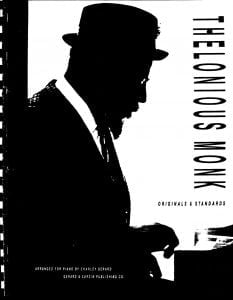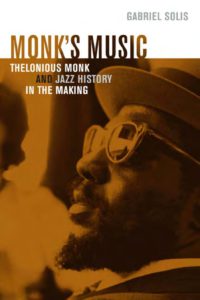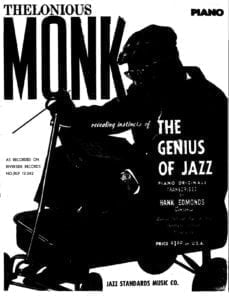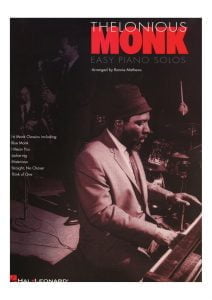Browse in the Library:
and subscribe to our social channels for news and music updates:
Search Posts by Categories:
Along with Charlie Parker and Dizzy Gillespie, Thelonious Monk (1917-1982) was a vital member of the jazz revolution which took place in the early 1940s.
Monk’s unique piano style and his talent as a composer made him a leader in the development of modern jazz. Find his sheet music transcriptions in our Library.
He’s not just another genius pianist. We are proud to have many of Thelonious monk’s piano sheet music transcriptions and melodies in our Library.
When Thelonious Monk began performing his music in the early 1940s, only a small circle of New York’s brightest jazz musicians could appreciate its uniqueness. His melodies were angular, his harmonies full of jarring clusters, and he used both notes and the absence of notes in unexpected ways. He flattened his fingers when he played the piano and used his elbows from time to time to get the sound he wanted.
Critics and peers took these as signs of incompetency, giving his music “puzzled dismissal as deliberately eccentric,” as Jazz Journal noted. “To them, Monk apparently had ideas, but it took fleshier players like pianist Bud Powell to execute them properly.” The debate over his talent and skill continued as the years passed, but Monk eventually found himself with a strong following. By the time of his death in 1982 he was widely acknowledged as a founding father of modern jazz.

Aspects of his compositions that once were ridiculed are now analyzed at colleges and universities throughout the country. Amateur and professional pianists continue to cite him as a major influence in their styles. Many of his works, which number over 60, are jazz classics. “Round Midnight” is considered “one of the most beautiful short pieces of music written in twentieth-century America,” as record producer Orrin Keepnews noted in Keyboard Magazine.
Browse in the Library:
and subscribe to our social channels for news and music updates:
Though his career was beset by personal and societal obstacles, Monk always believed in his music. He never spoke to his audiences end rarely granted interviews, preferring to let his music speak for itself. Aside from his wife and two children, his music was his life.
“So absorbed was he in jazz,” commented Keyboard, “that he would walk the New York streets for hours or stand still on a corner near his apartment on West 63rd Street, staring into his private landscape and running new songs and sounds through his mind. As he himself succinctly explained it, ‘I just walk and dig.”

Because Monk’s music was beyond the grasp of most listeners, the media tended to look for peripheral details to write about. They had plenty of material; as the New York Post wrote, Monk was “one of jazz’s great eccentrics.” During concerts and recording sessions he would rise from his bench every so often and lunge into a dance, emphasizing the rhythm he wanted from his bandmembers with his 200-pound frame.
With his strange hats, bamboo-framed sunglasses, and goatee, he became an obvious subject for Sunday supplement caricatures. There was also the way he talked: He and his peers—saxophonist Charlie Parker, trumpeters Dizzy Gillespie and Miles Davis, drummer Max Roach, and tenor saxophonist Sonny Rollins—were known for popularizing such expressions a “groovy,” “you dig, man,” and “cool, baby.”
But most Americans first heard of him in the early 1950s when he and a couple of friends were arrested for allegedly possessing drugs—for Monk, one among other instances of legal harassment that would create severe obstacles in his work.
Surprisingly, there are no biographies in book form on Monk. There is, however, the excellent 1989 film documentary, Straight, No Chaser (Warner Bros.), which combines footage shot in the late 1960s with more recent interviews with his son, Thelonious Monk, Jr., tenor saxophonist Charlie Rouse, and others. According to a New York Times interview, the film features “some of the most valuable jazz ever shot. Closeups of Monk’s hands on the keyboard reveal a technique that was unusually tense, spiky and aggressive.
Other scenes show him explaining his compositions and chord structures, giving instructions in terse, barely intelligible growls that even his fellow musicians found difficult to interpret.” The film also provides glimpses into the emotional turbulences in his personal life. He was “acutely sensitive and moody and perhaps a manic-depressive,” according to the same review. “Illness eventually made it impossible for him to perform.”

Teaches Self to Read Music
Thelonious Sphere Monk was born October 10, 1917, in Rocky Mount, North Carolina. The first musical sounds he heard were from a player piano that his family owned. At the age of five or six, he began picking out melodies on the piano and taught himself to read music by looking over his sister’s shoulder as she took lessons.
About a year later, the family moved to the San Juan Hill section of New York City, near the Hudson River. His father became ill soon afterward and returned to the South, leaving Thelonious’s mother, Barbara, to raise him and his brother and sister by herself. Mrs. Monk did all she could to encourage her young son’s interest in music.
Though the family budget was tight, she managed to buy a baby grand Steinway piano, and when Thelonious turned 11 she began paying for his weekly piano lessons. Even at that young age, it was clear that the instrument was part of his destiny. “If anybody sat down and played the piano,” he recalled in Crescendo International, “I would just stand there and watch ’em all the time.”
As a boy Thelonious received rigorous training in the gospel music style, accompanying the Baptist choir in which his mother sang and playing piano and organ during church services. At the same time he was becoming initiated into the world of jazz; near his home were several jazz clubs as well as the home of the great Harlem stride pianist James P. Johnson, from whom Thelonious picked up a great deal. By the age of 13 he was playing in a local bar and grill with a trio.
A year later he began playing at “rent” parties (parties thrown to raise money for rent), which meant holding his own among the pianists who would each play in marathon displays of virtuosity. He gained further distinction at the Apollo Theater’s famous weekly amateur music contests, which he won so many times that he was eventually banned from the event. At 16 he left school to travel with an evangelical faith healer and preacher for a year-long tour that indoctrinated him into the subtleties of rhythm and blues accompaniment.

“I was about nineteen to twenty, I guess, when I started to hear my music in my mind,” Monk told Crescendo International. “So I had to compose music in order to express the type of ideas that I had. Because the music wasn’t on the scene. It had to be composed…. All the musicians that were thinking liked my music—and wanted to learn how to play the different songs that we were playing. And the most talented ones used to be on the scene.
Like Charlie Parker and Dizzy. They were about the fastest-thinking musicians. And so they would come and play all the time, and I would teach ’em the songs, you know, and the chords. They didn’t just hear it. I had to tell ’em what it was…. They got themselves together by playing a lot with me…. I wasn’t trying to create something that would be hard to play. I just composed music that fit with how I was thinking…. I didn’t want to play the way I’d heard music played all my life. I got tired of hearing that. I wanted to hear something else, something better.”
As the 1940s progressed and bebop became more and more the rage, Monk’s career declined. “By 1948,” Keyboard noted, “he was only doing occasional nights at Birdland, and days were often spent sitting in his room, writing tunes, gazing silently at the television, or staring for long hours at a pictured Billie Holiday taped to his ceiling…. Nellie, his wife, helped keep food on the table with outside work during his periods of moody immobility.”
In 1951, he was arrested with pianist Bud Powell on an extremely questionable charge of narcotics possession. Not only was he confined for 60 days in prison, but the New York State Liquor Authority rescinded his cabaret card, without which he could not get hired for local club dates. For the next several years he survived only with the help of his good friend and patron, the Baroness de Koenigswarter.

By the mid-1950s, though, his fortune took a turn for the better. In 1954, he gave a series of concerts in Paris and cut his first solo album, Pure Monk (now out of print). A year later, he began recording for the Riverside label. His following grew, and as Keyboard reported, his mystique grew as well. “Program notes for the Berkshire Music Barn Jazz Concert in 1955 read, ‘Monk is the Greta Garbo of jazz, and his appearance at any piano is regarded as a major event by serious followers of jazz.”
In 1957, he opened an engagement at New York’s Five Spot, leading a powerful quartet with a jazz newcomer named John Coltrane on saxophone. The gig, which lasted eight months, was pivotal for Monk. “Monk found himself at the center of a cult,” wrote Keyboard. “Audiences lined up to see his unpredictable performances, his quirky, quietly ecstatic dances during horn solos, his wanderings through the room.” Several masterful albums he recorded for Riverside in the late 1950s—Brilliant Corners, Thelonious Himself, and Thelonious Monk with John Coltrane—increased his notoriety, rendering him “the most acclaimed and controversial jazz improviser of the late 1950s almost overnight.”
It didn’t hurt that both Coltrane and Sonny Rollins were acknowledging him as their guru. “With men as highly regarded as those acknowledging his mastery,” Keepnews commented in Keyboard, “the rest of the jazz world was quick to follow…. I could not [without] both satisfaction and amusement [describe] the quick change in his downbeat record reviews from lukewarm or less to their top 5-star rating.”
The strange behavior that Monk displayed in public sometimes got him into trouble. In 1958 he was arrested, undeservedly, for disturbing the peace, and his cabaret license was revoked a second time. Forced to take out-of-town gigs, he was separated from his two main sources of stability—New York City and his wife Nellie—and his eccentricities thus intensified.
During one episode in 1959 in Boston, state police picked him up and brought him to the Grafton State Hospital, where he was held for a week. “From that point on,” Keyboard wrote, “when asked about his eccentricities, Monk would answer, ‘I can’t be crazy, because they had me in one of these places and let me go.” Around 1960 his cabaret club card was restored and he returned to playing the New York clubs. Now when he played a gig his wife accompanied him; when she couldn’t make it, he telephoned her during breaks.
Toward the end of the 1950s Monk began to receive the prestige he had for so long deserved. His late 1950s recordings on Riverside had done so well that in 1962 he was offered a contract from Columbia. As a performer he was equally successful, commanding, in 1960, $2,000 for week-long engagements with his band and $1,000 for single performances. His December 1963 concert at New York’s Philharmonic Hall, a big-band presentation of originals, was for him a personal landmark.
As Keyboard observed, “the Philharmonic Hall was special: it was within walking distance of his apartment, a part of the neighborhood he had criss-crossed on his long meditative strolls. After years of hassles with local clubs and unsympathetic critics, Monk had finally made it close to home.” In 1964 he appeared on the cover of Time magazine—an extremely rare honor for jazz artist.
Looking back on his career, Monk told Crescendo International, “As for the hard times I’ve had—I’ve never been jealous of any musician, or anything. Musicians and other people have told lies on me, sure, and it has kept me from jobs for awhile…. But it didn’t bother me. I kept on making it—recording and doing what I’m doing, and thinking.
While they were talking, I was thinking music and still trying to play. And I never starved. I always could make it…. What turned the tide in my favour? The sons took over. A lot of the fathers kicked off, went out of business, or retired. And their sons are in power now, that like different music and take better chances. In other words, it’s younger people running things…. I take it as it comes—as long as I can make a living, take care of my family and everybody can be comfortable. And if I can do what I want when I feel like doing it—which generally means financially—then everything is all right.
If you want to eat, you can buy some food. If you want a suit, you can buy one. If you don’t want to walk, you can ride in a cab, or buy a car. That’s all you need to do. Sleep when you want, get up when you want— be your own boss…. I’ve never wished for anybody else’s job. I enjoy what I do, and I’m myself all the time. And I’ll continue to be me.”
Browse in the Library:
and subscribe to our social channels for news and music updates: